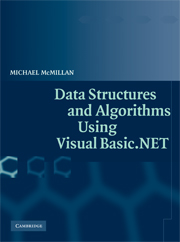Book contents
- Frontmatter
- Contents
- Preface
- Introduction
- Chapter 1 Collections
- Chapter 2 Arrays and ArrayLists
- Chapter 3 Basic Sorting Algorithms
- Chapter 4 Basic Searching Algorithms
- Chapter 5 Stacks and Queues
- Chapter 6 The BitArray Class
- Chapter 7 Strings, the String Class, and the StringBuilder Class
- Chapter 8 Pattern Matching and Text Processing
- Chapter 9 Building Dictionaries: The DictionaryBase Class and the SortedList Class
- Chapter 10 Hashing and the HashTable Class
- Chapter 11 Linked Lists
- Chapter 12 Binary Trees and Binary Search Trees
- Chapter 13 Sets
- Chapter 14 Advanced Sorting Algorithms
- Chapter 15 Advanced Data Structures and Algorithms for Searching
- Chapter 16 Graphs and Graph Algorithms
- Chapter 17 Advanced Algorithms
- References
- Index
Chapter 15 - Advanced Data Structures and Algorithms for Searching
Published online by Cambridge University Press: 11 August 2009
- Frontmatter
- Contents
- Preface
- Introduction
- Chapter 1 Collections
- Chapter 2 Arrays and ArrayLists
- Chapter 3 Basic Sorting Algorithms
- Chapter 4 Basic Searching Algorithms
- Chapter 5 Stacks and Queues
- Chapter 6 The BitArray Class
- Chapter 7 Strings, the String Class, and the StringBuilder Class
- Chapter 8 Pattern Matching and Text Processing
- Chapter 9 Building Dictionaries: The DictionaryBase Class and the SortedList Class
- Chapter 10 Hashing and the HashTable Class
- Chapter 11 Linked Lists
- Chapter 12 Binary Trees and Binary Search Trees
- Chapter 13 Sets
- Chapter 14 Advanced Sorting Algorithms
- Chapter 15 Advanced Data Structures and Algorithms for Searching
- Chapter 16 Graphs and Graph Algorithms
- Chapter 17 Advanced Algorithms
- References
- Index
Summary
In this chapter, we present a set of advanced data structures and algorithms for performing searching. The data structures we cover include the red–black tree, the splay tree, and the skip list. AVL trees and red–black trees are two solutions to the problem of handling unbalanced binary search trees. The skip list is an alternative to using a treelike data structure that foregoes the complexity of the red–black and splay trees.
AVL Trees
Named for the two computer scientists who discovered this data structure—G. M. Adelson-Velskii and E. M. Landis—in 1962, AVL trees provide another solution to maintaining balanced binary trees. The defining characteristic of an AVL tree is that the difference between the height of the right and left subtrees can never be more than one.
AVL Tree Fundamentals
To guarantee that the tree always stays “in balance,” the AVL tree continually compares the heights of the left and right subtrees. AVL trees utilize a technique, called a rotation, to keep them in balance.
To understand how a rotation works, let's look at a simple example that builds a binary tree of integers. Starting with the tree shown in Figure 15.1, if we insert the value 10 into the tree, the tree becomes unbalanced, as shown in Figure 15.2. The left subtree now has a height of 2, but the right subtree has a height of 0, violating the rule for AVL trees.
- Type
- Chapter
- Information
- Data Structures and Algorithms Using Visual Basic.NET , pp. 298 - 319Publisher: Cambridge University PressPrint publication year: 2005



